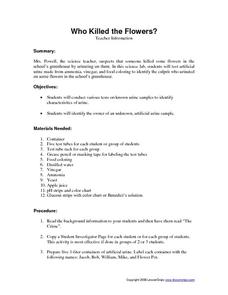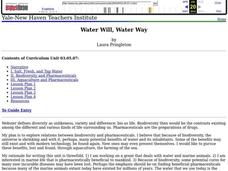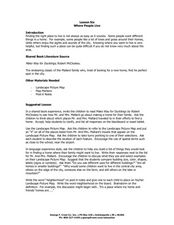Curated OER
Introduce /ph/
Students practice using /ph/ as it makes the /f/ sound. In this /ph/ lesson, students examine the /ph/ combination when it is written on the board. They identify items and words that contain the /f/ sound that is spelled using the /ph/...
Curated OER
Water Quality in the Greenhills Stream
Seventh graders conduct year long study of water quality over different seasons using variety of probes, including D.O., pH, conductivity and temperature, that are attached to portable technology. Students select three data points in...
Curated OER
Reintroduce /ph/
Young scholars review the letter combination "ph" and its pronunciation. For this "ph" letter combination lesson, students practice a mix of 12 letter combinations on the board then take turns recognizing the proper sounds of the "ph"...
Lesson Snips
Who Killed the Flowers?
This could be really good, or it could be really bad! The crime to be solved is, "Who went pee in the flowerpot?" Given four imitation urine samples, young chemists or crime scene investigators perform pH, glucose, and turbidity...
Curated OER
Reintroduce /aw/
Students are reintroduced to the letter combination 'aw' and its sound. In this lesson on the 'aw' letter combination, students practice reciting a mix of 12 letter combinations on the board and take turns identifying 'aw' letter...
Curated OER
Do We Need to Wear a Rainhat? Acid Rain: Causes, Effects, and Possible Solutions
Acid rain, and how it affects the environment, is the focus of this Earth science instructional activity. During the study, learners evaluate measures to reduce acid rain, and design an investigation to demonstrate the conection between...
Curated OER
Reintroduce /wr/
Students recognize that the /wr/ sound has the same sound a /rrr/. In this /wr/ sound lesson plan, students locate the wr in a random chart of letter clusters. Students pronounce the words with wr.
Baylor College
Lungometer
Life science learners construct lung-o-meters from gallon-sized milk jugs and then measure their lung capacities. For older students, have them graph the vital lung capacities of each person in the class. Cross-curricular pieces are...
Curated OER
Turbidy and Water
Students use observation skills in assessing the water quality of water samples in this activity and learn that the tastes and preferences of others can be different.
Curated OER
Reading Food Labels
Students investigate the concept of phonemic awareness in order to help increase reading comprehension. The reading of food labels creates the context for the practice session. They pay particular attention to certain sounds that must be...
Curated OER
Looking for Local Public Art
Students explore artwork in the local community. They increase their knowledge about their community. They create a slide show presentation with sounds, text and transitions.
Curated OER
Wh Questions (Who, What, Where, When)
In this question words worksheet, students write the appropriate WH question for the underlined word in the first 8 sentences. Students then write the appropriate WH question that will have the stated sentence as an answer for the 5...
US Department of Energy
Geothermal Energy
With Earth Day quickly approaching, as well as many science fairs, why not challenge your class to investigate geothermal energy or other renewable energy resources? There are five driving questions explored in depth here, as well as...
Curated OER
Jeffrey and Sloth: Six Traits of Writing
Use drawings as inspiration. Have learners doodle for 10 minutes before beginning the lesson. Then, have them use their doodles to inspire a story. Several writing activities are included here to play with writing. One of my favorites...
Science Friday
Microorganisms on the Move
You can't b. cereus until you see this lesson! Young microbiologists learn to prepare deep well slides, observe two types of microorganisms, and compare and contrast their physical characteristics in this interactive and lively activity.
EngageNY
Logarithms—How Many Digits Do You Need?
Forget your ID number? Your pupils learn to use logarithms to determine the number of digits or characters necessary to create individual ID numbers for all members of a group.
Curated OER
International Festival: Greece
Students celebrate the culture of Greece. For this multicultural lesson, students participate in several activities which examine the culture of Greece. Students study the Greek alphabet, identify the country on a world map, and make...
Curated OER
Adult ESOL Lesson Plan - Effective Telephone Communication
Students examine and practice the ability to use basic residential telephones. They practice specific phrases and vocabulary terms to assist them with this task. In addition, they practice writing down each other's phone numbers.
Curated OER
The Cuban Missile Crisis
High schoolers reflect on the events that lead up to the Cuban Missile Crisis in the early 1960s. In this history lesson plan, students explore the conflicts between the United States and the Soviet Union revolving around missiles...
Curated OER
Water Will, Water Way
Students test tap water for hardness and mineral content. In this environmental science lesson, students identify the different stages of the water cycle. They classify plant and animals according to the rules of taxonomy.
Curated OER
Digraphs
Sixth graders participate in a word study activity to increase vocabulary and spelling accuracy. In this digraphs instructional activity, 6th graders understand how the letter "h" changes and initial sound. Students complete a crossword...
Curated OER
Lesson Six Where People Live
Young scholars investigate where people live. In this early geography lesson, students read Make Way for Ducklings! by Robert McCloskey and then discuss what neighborhoods are as they identify them on landscape picture maps.
Curated OER
Canvas Transformations
Students transform the content of paintings currently in the collection hanging in the Utah Fine Arts Museum by using the four theatre techniques of storytelling, kinetics images, soundscapes, and ritual building.
Curated OER
ESOL Health and Nutrition
Students brainstorm and discuss vocabulary words which identify various health care providers and facilities. They work in pairs and share their own health care experiences and write sentences about them.

























